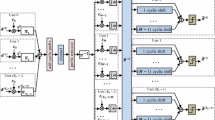Abstract
Considering an Orthogonal Frequency Division Multiple Access (OFDMA) system, in this study we analyze the role of interleavers from their capability in ensuring uniformity of Bit Error Rate (BER) performance amongst the active users. In addition, we also investigate their Peak to Average Power Ratio (PAPR) properties. From the uniformity or fairness in BER perspective, we first consider a generic system and show that for a slowly changing multipath channel, individual user’s BER performance can vary from each other to a great extent, implying that the propagation channel effect is unfairly distributed on the users. Applying different types of frequency interleaving mechanisms, we demonstrate that the choice of interleaving can ensure better BER fairness on an individual user basis. In particular, by introducing the application of cyclically shifted random interleaver, we demonstrate its effectiveness in achieving BER fairness dispersion in individual users BER reduced by 89% compared to no interleaving at 15 dB Signal to Noise Ratio. We then explore the comparative performance of different interleavers considering variable number of total subcarriers, variable number of users and variable number of subcarriers per users. Finally, going back to the generic OFDMA, we investigate the PAPR distribution of different interleavers at various active user densities. Based on the results we conclude that when the total number of subcarriers per user is relatively low, i.e., a system which is heavily loaded with active users, cyclically shifted random interleavers can effectively ensure uniform performance amongst active users with reduced system complexity and manageable PAPR. In all other cases, interleaving with fixed amount of subcarrier spacing is the best solution.
Similar content being viewed by others
References
IEEE Standard for Local and Metropolitan Area Networks Part 16: Air Interface for Fixed Broadband Wireless Access systems (2004). ANSI/IEEE std. 802.16-2004 (Revision of IEEE Std. 802.16-2001).
http://www.3gpp.org (2011).
Kulkarni, G., Adlakha, S., & Srivastava, M. (2005). Subcarrier allocation and bit loading algorithms for OFDMA-based wireless networks, IEEE Transactions on Mobile Computing, 4(6). doi:10.1109/TMC.2005.90.
Cao, Z., Tureli, U., & Liu, P. (2003). Optimum subcarrier assignment for OFDMA uplink. In Thirty-seventh asilomar conference on signals, systems and computers.
Toktas, E., Biyikoglu, E. U., & Yilmaz, A. O. (2009). Subcarrier allocation in OFDMA with time varying channel and packet arrivals. In Proc. European wireless conference 2009 (European 2009), May.
Wang, H., & Chen, B. (2004). Asymptotic distributions and peak power analysis for uplink OFDMA signals. In Proc. IEEE international conference on acoustics, speech, and signal processing, May.
Xiao, Y., Peng, Y., & Li, S. (2007). PAPR reduction for interleaved OFDMA with low complexity. In Proc. 6th international conference on information, communications and signal processing, December.
He, X., Xiao, Y., & Li, S. (2008). PAPR reduction of random interleaved uplink OFDMA system. In Proc. 3rd international conference on communications and networking in China (ChinaCom).
Ahmed, S., & Kawai, M. (2010). Interleaver-based subcarrier allocation schemes for BER fairness in OFDMA. In Proc. 9th international conference on wireless networks (ICWN 2010), July (pp. 262–266). ISBN: 1-60132-150-3.
Ahmed, S., & Kawai, M. (2011). Effects of interleavers on BER fairness and peak to average ratio in OFDMA system. In International symposium on wireless and pervasive computing (ISWPC 2011), February.
Jain, R., Chiu, D., & Hawe, W. (1984). A quantitative measure of fairness and discrimination for resource allocation in shared computer systems (DEC Research Report TR-301). September. http://www1.cse.wustl.edu/~jain/papers/fairness.htm.
Goldsmith, A. (2005). Wireless communications. Cambridge: Cambridge University Press, Chap. 12.
Kusume, K., & Bauch, G. (2008). Simple construction of multiple interleavers: cyclically shifting a single interleaver. IEEE Transactions on Communications, 56(9). doi:10.1109/TCOMM.2008.060420.
Goldsmith, A. (2005). Wireless communications. Cambridge: Cambridge University Press, Chap. 2.
Author information
Authors and Affiliations
Corresponding author
Additional information
This work was supported in part by Global COE Program for Education, Research and Development of Strategy on Disaster Mitigation of Cultural Heritage and Historic Cities, MEXT, Japan. Part of this paper was presented at the International Symposium on Wireless and Pervasive Computing (ISWPC 2011).




